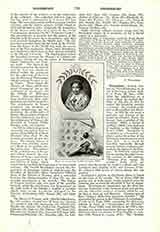

Tournefort, JOSEPH PITTON DE, French botanist, b. at Aix in Provence, June 5, 1656; d. at Paris, December 28, 1708. After his school-days at a Jesuit college he studied theology at Aix, but in 1677 he turned his attention entirely to botany. He studied medicine at Montpellier and Barcelona. In 1683 he was made a professor and director at the Jardin des Plantes, Paris; he became later a member of the Academy (1692), a doctor of medicine (1698), and professor of medicine at the College de France (1702). Tournefort is recognized as a botanical explorer, and as the author of the artificial system of plants named after him. As a youth he traveled repeatedly through western Europe, exploring particularly the region of the Pyrenees. In 1700-2 he visited the Orient, passing through Greece. The account of this journey, “Relation dun voyage du Levant” (Paris, 1717) appeared after his death; this work is a classic and was translated into English (1741) and German (1776). He collected 1356 species of plants during this one journey.
Tournefort’s system of classifying plants is based on the form of the corolla. Up to about 1750 the system was in high repute, being accepted even by Linnaeus, but as research advanced it lost its importance. Of permanent importance are the clear distinction Tournefort makes between genus and species, and the exhaustive analyses of genera which he was the first to draw up and illustrate. Linnaeus says of him: “Primus characteres genericos condidit.” He expounded his system in his “Eléments de botanique” (3 vols. in 8°, Paris, 1694), containing 451 plates; rewritten in Latin as “Institutiones rei herbariae” (3 vols., Paris, 1700), with 476 plates (in 1703 a supplement was issued containing thirteen plates; a new edition by Adrien de Jussieu in 1719; English tr., London, 1735, French tr., Lyons, 1797). The “Institutiones” was preceded by a defense of his system which was entitled, “De optima methode instituenda in re herbaria” (Paris, 1697), and by a “Histoire des plantes qui naissent aux environs de Paris” (Paris, 1698), an English translation of which appeared in 1732. A genus with about 120 species, belonging to the family of the Borraginaceae, was named by Linnaeus Tournefortia, and still retains this designation.
J. H. ROMPEL

